News Coverage

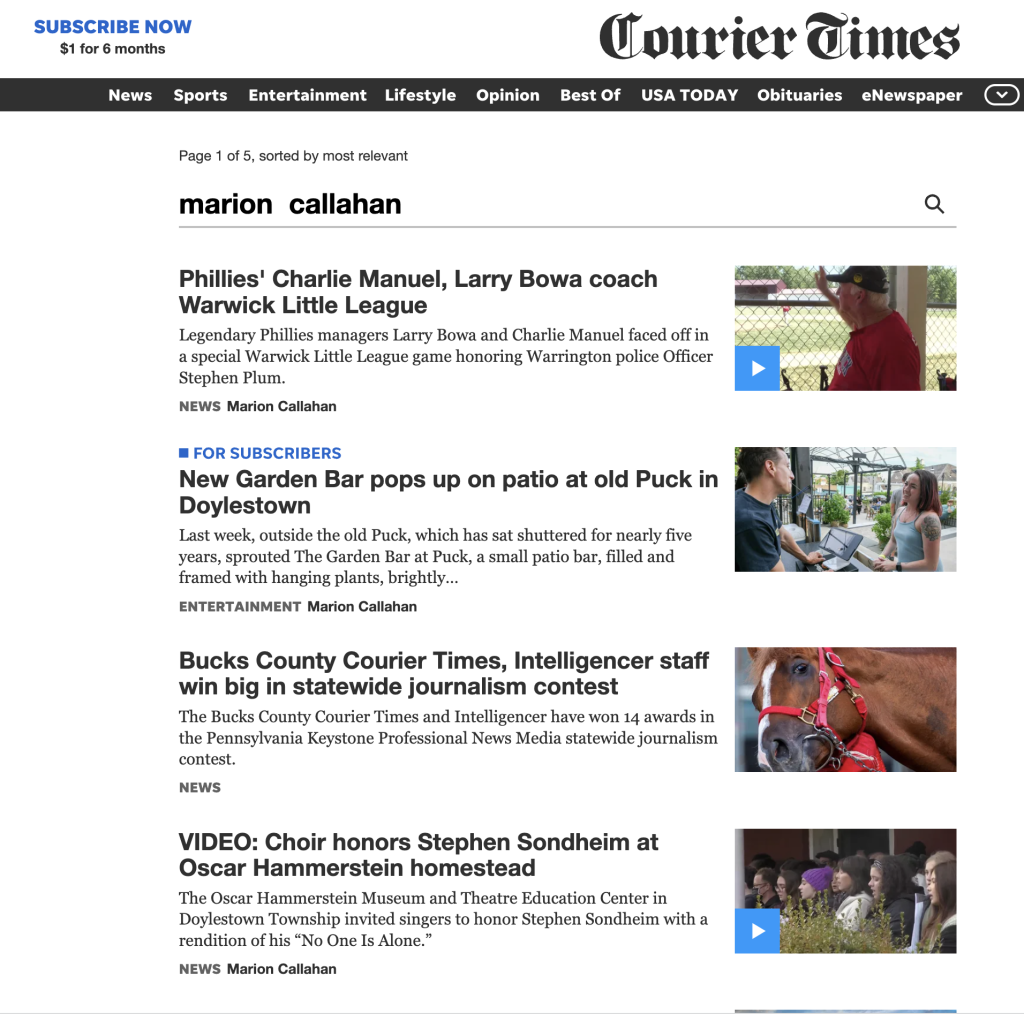
Reporting & Teaching: The best of both worlds
As a professor and freelance journalist, I had the pleasure of merging my two passions, educating and reporting on Election Day. After my classes ended, I was able to bring a student to my night assignment to cover the Pennsylvania’s governor’s race, showing her the versatile role we as journalists play, taking photos, filing updates to the copy desk at USA Today and delivering live video on Twitter and Instagram.
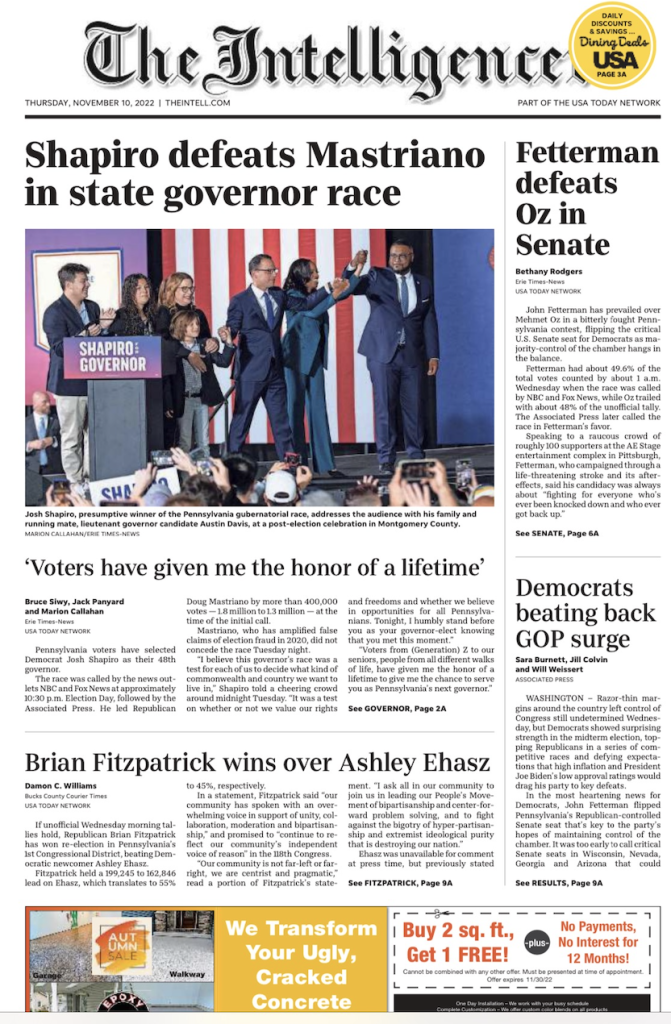
Some examples of my work:
Published in Bucks County Courier Times, USA Today, U.S. News & World Report: Once lost to addiction, She returns with message and hope
2022: Two first-place, Keystone News Media Awards: Video & Profile writing.
2021: Three first-Place, Keystone New Media Awards: Podcasting, Video, & consumer news.
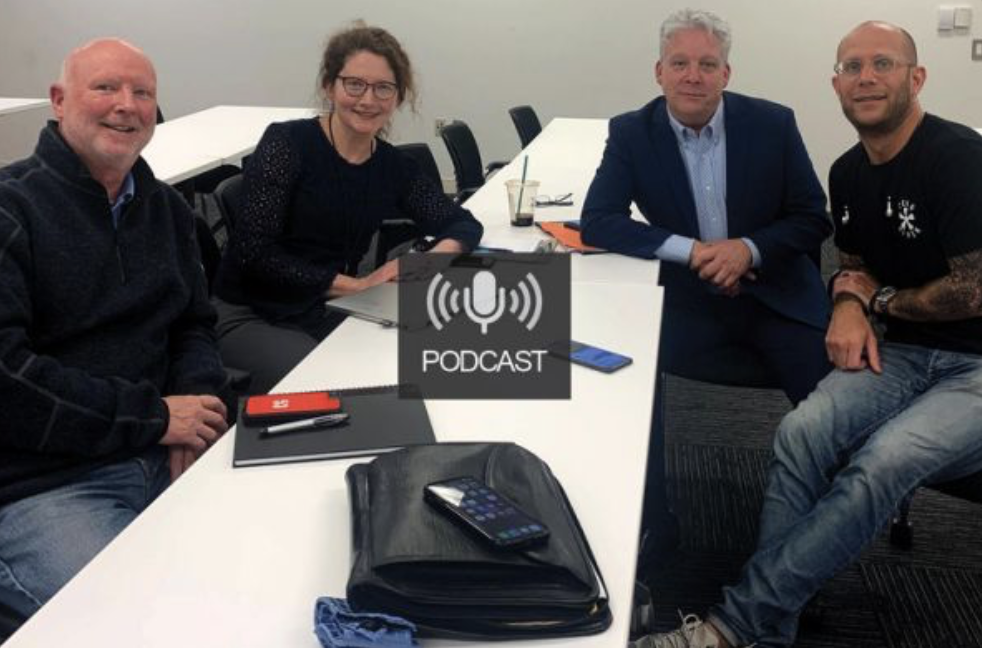
Interviews, like this one for a multimedia piece on Cyber Security, provided content for a podcast and a written enterprise story, which earned a first-place award from Pennsylvania NewsMedia Association for consumer news. Listen here:
2020: Pennsylvania NewsMedia Association Keystone Awards
- First place in Podcasting.
- 2nd place in photography for News Event Photo entitled “Homeless in the suburbs.”
- Honorable mention for “Ongoing News Coverage” for the Sean Kratz murder trial
Her recent work has been published in: USA Today, U.S. News & World Report, Yahoo, Christian Science Monitor, Seattle Times, Miami Herald, Washington Times, Kansas City Star, The Charlotte Observer, Lexington Herald-Leader, The Sacramento Bee, Fort Worth Star-Telegram, Times Union (Albany), WCAU-TV (Philadelphia, PA), WRAL-TV (Raleigh, NC), Des Moines Register, Government Technology, News & Observer, The Journal News, The Morning Call, Wichita Eagle, Asbury Park Press, CKWX-AM (Vancouver, BC), The State, WICU-TV (Erie, PA), Democrat and Chronicle, Fresno Bee, NorthJersey.com, CIWW-AM, Erie Times-News, Roanoke Times, Tacoma News Tribune, The News Journal, Bradenton Herald, Idaho Statesman, Richmond Times-Dispatch, San Luis Obispo Tribune, The Island Packet, Belleville News-Democrat, Columbus Ledger-Enquirer, The Herald-Sun (Durham, NC), The Modesto Bee, York Daily Record, Sun Herald, The Times Herald-Record, WTAE-TV (Pittsburgh, PA), American Military News, Centre Daily Times, WHYY-TV (Philadelphia, PA), MyCentralJersey.com, Rock Hill Herald, The Sun News, Courier-Post, New Jersey Herald, The Olympian, Times Leader (Wilkes-Barre, PA), Bryan-College Station Eagle, Bucks County Courier Times, Delaware Coast Press, Hagerstown Herald-Mail, Philadelphia Tribune, Poughkeepsie Journal, The Bellingham Herald, The Standard-Times, The Telegraph (Macon), Binghamton Press & Sun-Bulletin, Burlington County Times, Lebanon Daily News, LNP, The Sentinel, Pocono Record, Tri-City Herald, Bristol Herald Courier, Dothan Eagle, Merced Sun-Star, Daily Item, Observer-Reporter, Beaver County Times, The Taunton Daily Gazette, The Trentonian, CKGL, Ithaca journal, Telegraph Herald (Dubuque, Iowa), The Intelligencer (Doylestown, PA), The Observer-Dispatch, CFFR-AM (Calgary, AB), Daily Messenger, Herald Standard, Star Gazette, Public Opinion Online, The Evening Sun (Hanover, PA), New Castle News, The Bradford Era, Corning Leader, Daily American, The Hornell Evening Tribune, Ellwood City Ledger, The Wellsville Daily Reporter, Waynesboro Record Herald, Courier Express
2020 Highlights:


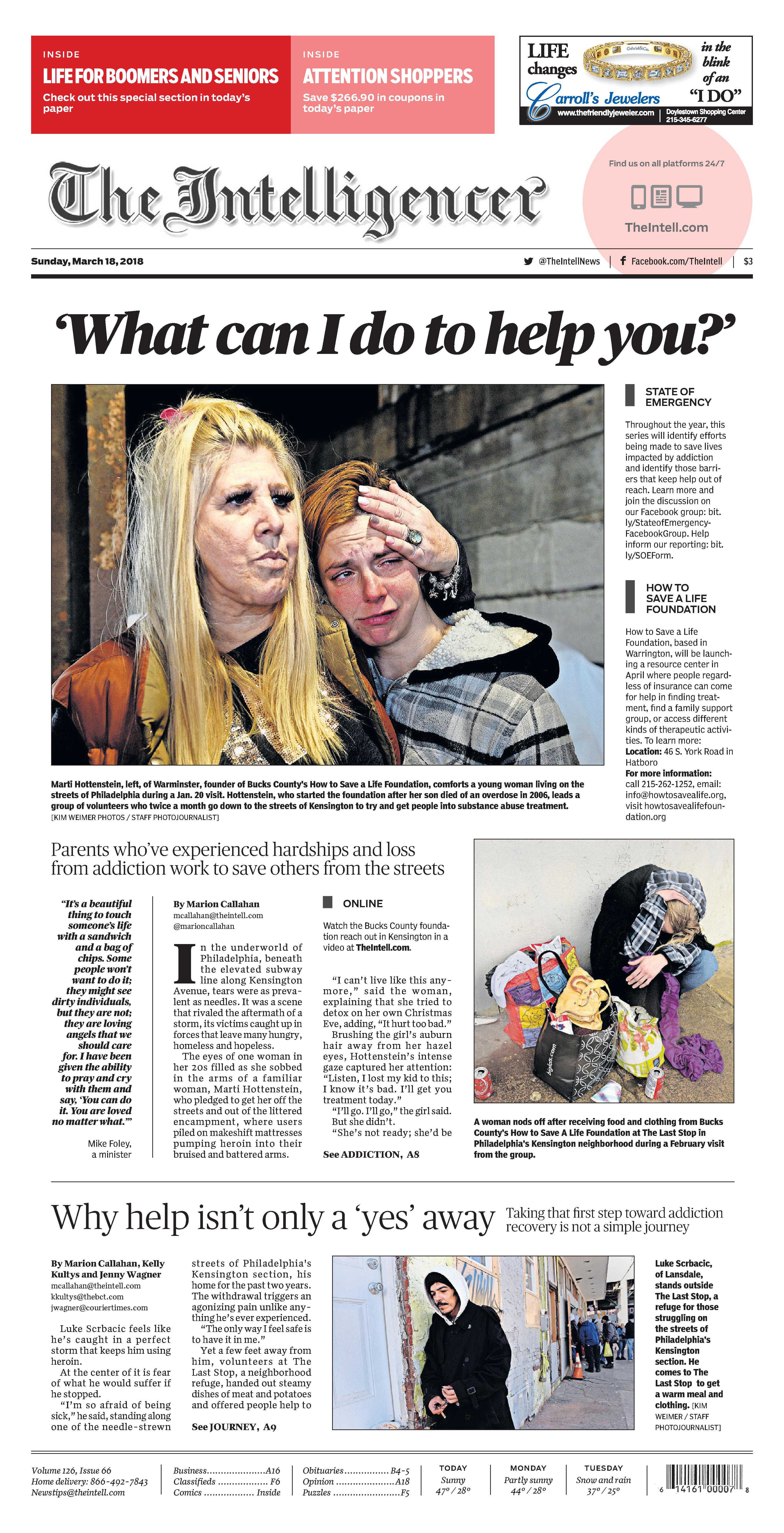


2019: Pennsylvania Keystone Award: First Place “State of Emergency” series.
2019: Pennsylvania Associated Press Managing Editors Award: First Place “State of Emergency” series.
2018: Pennsylvania Keystone Award: Second Place for a Sunday story on the gaps in the foster care system when it comes to caring for teens.
2018: PAPME/ Spotlight awards: First Place for a joint-series on young victims of the opioid crisis.
2017: Pennsylvania Keystone Awards: First Place for a series documenting the struggles facing those trying to rebuild their lives in addiction and the lack of accountability with recovery houses, “Recovery Road.”
2016: Pennsylvania Keystone Awards: First-place for series of stories highlighting the disparities in health care costs.
2015: Pennsylvania Associated Press Managing Editors Award: First place for investigative journalism, “Hidden World, Hidden Victims,” a multimedia series documenting human trafficking in the suburbs.
2014: Pennsylvania Keystone Award: first place, and Pennsylvania Associated Press Managing Editors Award, first place, “Heroin: It’s time for the talk.“
2010: Pennsylvania Newspaper Association’s Spotlight Award, The Morning Call. “A Love Story.”
Several other awards, including three on “Burb’s Eye View” columns, given between 2004-2008, provided upon request.
Package on Homelessness in the Suburbs: Photos & Story:
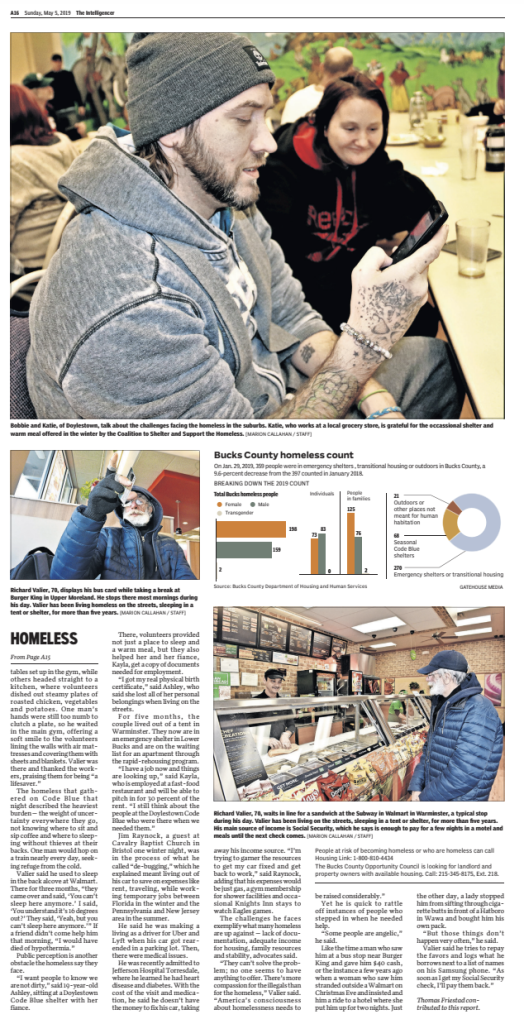
Long Road Between Survival, Stability for Suburban Homeless
https://www.usnews.com/news/best-states/pennsylvania/articles/2019-05-11/long-road-between-survival-stability-for-suburban-homeless
U.S. News & World Report, Tribune News Service, The Intelligencer, Bucks County Courier Times, Burlington County Times.
Full package:
Cosmo DiNardo killed 4 men on Bucks County farm. He now spends his days in a medium security prison.
https://www.mcall.com/news/pennsylvania/mc-nws-pa-cosmo-disnardo-bucks-county-killings-prison-20191125-r2yx64kfsjdv3ofbb4udidj7c4-story.html
The Seattle Times:
Ex-recovery house resident helps others out of addiction
https://www.seattletimes.com/nation-world/ex-recovery-house-resident-helps-others-out-of-addiction/
Trip to the beach sparks memories in dementia patients
https://www.seattletimes.com/nation-world/trip-to-the-beach-sparks-memories-in-dementia-patients/
Burlington County Times:
Imposter scams bilking consumers of millions
https://www.burlingtoncountytimes.com/news/20190308/imposter-scams-bilking-consumers-of-millions/1
August 2018:
Though the overdose death toll continues to rise, opioid addiction isn’t treated with urgency like other chronic and deadly diseases, according to national studies and treatment experts.
Though state and federal parity laws require certain types of insurance plans to cover mental health and addiction treatment on par with how they cover physical medical care, they are not always enforced.
Many families report battles with insurers in getting coverage for needed addiction treatment.
This includes situations when patients were discharged from residential care over clinicians’ objections because their insurer stopped paying. For example, Southampton resident Lisa LaTerza said her son, Matt Freda, almost lost insurance coverage 12 days after he began treatment at The Life Cycle of Galax in Virginia in 2016.
“We had gotten this far to get help and an insurance company that we pay for is going to stop him? I fought until I got to the top (of insurance company) and I told them that if he left that day, they would be responsible for his death,” said LaTerza, who felt it was unfair to have to beg for coverage. LaTerza didn’t believe her son’s emergency was treated like other medical emergencies.
“If he had any other kind of life-threatening disease, there would have been more consideration for treatment,” said LaTerza, who recalls her son being in a very fragile state at that point.
Even the arm of the Department of Labor tasked with enforcing the law — the Employee Benefits Security Administration — agrees it lacks the teeth to impose any penalties on insurers who violate laws by denying or delaying coverage. In an April report to Congress, Department of Labor officials said it was too limited to fully enforce the law
“By statute, the EBSA is precluded from directly enforcing the law against insurance companies, even when evidence that the insurance company is the party responsible for a parity violation,” a 2018 Department of Labor report states. ”(It) also cannot assess civil monetary penalties in egregious cases of noncompliance to deter bad actors.”
Of 1,700 reported complaints in recent years, the department found 300 instances of insurance companies violating parity laws by limiting treatment, requiring higher co-pays and lower visit limits than for other medical services and imposing “overly restrictive fail-first policies.” This is where a patient must fail a less expensive form of treatment before being allowed to access another. Other violations included “impermissible annual and lifetime dollar limits.”
Generally, if violations are found, the agency requires insurers to pay any improperly denied benefits, but violators face no added penalty. Yet government reports say greater penalties for violations are needed to improve compliance.
Both the Mental Health Parity and Substance Use Disorder Parity Task Force and the President’s Commission on Combating Drug Addiction and the Opioid Crisis have recommended that Congress enact legislation to allow direct enforcement against insurers to ensure compliance with the law.
In a Pennsylvania House hearing last year, Samuel R. Marshall of The Insurance Federation of Pennsylvania testified that lawmakers “should not confuse an insurer questioning and examining a provider’s treatment plan with not complying with state and federal law.”
“A mandate is not a carte blanche for unquestioned treatment to the limits of the mandate,” he said. “Before mandating any level of expanded coverage, the General Assembly should hear from a wide group of providers. Cost has to be a consideration.”
“In the world of insurance regulation, the way to stop a bad insurer is to enact a law that outlaws that practice. The same needs to apply for providers,” Marshall said.
In a report to the president in 2016, The Commission on Combating Drug Addiction and the Opioid Crisis argued the act of denying “real parity is already illegal.”
“At this point, the largest outstanding issue is treatment limits. Patients seeking addiction treatment, including MAT, are often subjected to dangerous fail-first protocols, a limited provider network, frequent prior authorization requirements, and claim denials without a transparent process,” the commission stated.
Parity requirements extend to things like out-of-pocket costs and even the number of medications that are covered by plans, said Dr. Richard Snyder, chief medical officer of Independence Blue Cross.
“The inequity that we saw years ago between mental health and substance use benefits and medical benefits doesn’t exist today,” he said. “The mental health parity monitoring that the federal government is doing now pretty much ensures that there’s close alignment between the behavioral health and the medical benefits. And that is great.”
But more work needs to be done, some treatment providers and families say.
After a two days of phone calls with insurance officials, LaTerza did get the insurance company to pay for the remaining 18 days for her son to finish inpatient treatment.
“If he left that day, he would not be here today,” said LaTerza, adding that families shouldn’t have to beg for coverage of treatment they’ve already paid for.
Deb Beck, president of a prevention and treatment advocacy group, Drug and Alcohol Service Providers Organization of Pennsylvania, said some progress has been made in improving access to treatment for about 25 percent of insured residents of Pennsylvania who are covered under the state’s Act 106 law. The act was upheld by the Pennsylvania Supreme Court in 2009.
When state residents call Beck’s office asking for help, employees make sure they understand their coverage under the state law, she said. Her wish is that insurers and government officials would launch a public awareness campaign with letters and notices to consumers to alert them to treatment coverage they have and how to access it so they don’t have to fight to get help when they need it.
“Right now many patients don’t know how to access their health plan or what their benefits are,” she said. “Everybody has some kind of coverage, but try to access it? That’s where the barriers are.”
- June 2018: Facebook Live hosting: I was proud to represent my news organization, helping to “knock out” hunger in Bucks County via Facebook Live.

Local stories picked by national news
Schools Use Yoga, Meditation to Boost Learning, Ease Stress
Educators in Central Bucks, Centennial, Bensalem and other Bucks County school districts are increasingly turning to mindfulness practices, including meditation and focusing activities, to help students learn and decrease anxiety and stress.
June 9, 2018, at 3:05 a.m.

By MARION CALLAHAN, Bucks County Courier Times
PLUMSTEAD, Pa. (AP) — From an area that looks more like a yoga and recreation room than a traditional classroom, a new kind of learning was unfolding at Groveland Elementary School in Plumstead.
Fourth-grader Jordan Pieczynski jogged in place beneath a ceiling covered in clouds. A few minutes later, first-grader Adrian Yaeger closed his eyes and smiled as he pictured himself having fun at recess. Second-grader Dustin Balascia bounced on a trampoline.
The activities — some calming and some stimulating — are part of an educational initiative to help students learn by first helping them become mindful of themselves, their emotions and their surroundings. Embraced by several area school districts, mindfulness and emotional support programs are increasingly becoming part of a student’s day, whether it’s kickstarting a class with movement, setting goals and intentions during yoga, or taking a few minutes in class to reset with a “brain break” or sensory experience.
Approaches to mindfulness lessons vary among districts. But educators in Central Bucks, Bensalem and Centennial schools expressed a common goal: to empower students to learn.
“The mindfulness piece should be a key part in all schools,” said Dave Heineman, principal at Groveland. “It helps kids get themselves to a point where they are ready to learn. They understand their bodies, and understand what they need to be successful.”
While some students eagerly join in the lessons, others need a little more convincing, said guidance counselor Michelle Fuentes, who introduced the program to Groveland earlier this year. That’s when she points at a display of the brain in the school’s mindfulness room and describes the biological and academic benefits to the breathing, stretching and sensory activities.
“When they learn they have the skills to help them access the pre-frontal cortex, which helps them focus more, they buy into it more,” said Fuentes, who said the mindfulness exercises are introduced to all students at the school.
Centennial Superintendent David Baugh, who launched a mindfulness program when he worked in the Bensalem School District in 2014, has seen the benefits in the classroom, where he said students are more energetic, more focused and more capable of handling anxiety.
“It helps youngsters develop self control and self regulation,” Baugh said. “This seems like a good thing — especially in these days of high anxiety. It helps regulate anxiety when people are having panic attacks. They are developing skills to handle it and (it) helps them focus in class.”
Baugh said a growing body of evidence suggests mindfulness practices have clear health and learning benefits. Scientists have been able to prove that meditation and rigorous mindfulness training can lower blood pressure and levels of the stress hormone cortisol. Neuroscientists have shown that the strategies help memory and decrease mind-wandering.
MRI scans show that after a two-month mindfulness practice study, the brain’s amygdala appears to shrink. This region of the brain, associated with fear and emotion, is involved in the initiation of the body’s response to stress. The 2013 study, published by Public Library of Science and also backed by Harvard studies, showed that as the amygdala shrinks, the pre-frontal cortex — associated with higher-order brain functions such as awareness, concentration and decision-making — becomes stronger.
Central Bucks West High School house principal Todd Cantrell said mindfulness practices are taught to students having anxiety about attending school or transitioning from middle to high school. The nine-week program recruits students who are struggling. In the long run, he said, the use of mindfulness strategies serve as a preventative measure — teaching students to manage and cope with stresses that could lead to unhealthy behaviors, ranging from procrastination to self-medication.
“We recognize stress is a normal part of life, but we can teach them to recognize it, manage stress and de-escalate it,” said Cantrell, who now instructs teachers from other districts, including Council Rock and Pennridge, on how to apply it in the classroom.
Bensalem School District instructional coach Lee Cousin said even a two-minute break to “reset the brain” gets students more active in class and engaged following the activity.
Baugh said all teachers in Centennial have gone through neuroscience training through the professional development arm of The Franklin Institute, which offers a program on “how the brain works best,” he said. Instructional strategies such as stretching breaks, the scheduling of multiple activities to break up a lengthy class and even just allowing students to stand instead of sit all class helps the learning process, he said.
“We are embedding this in the health curriculum because of the incredible number of challenges and problems kids are facing these days,” he said.
Heineman, from Groveland, said last year some students were so anxious they couldn’t get out of the car to come into school. With levels of stress in students rising, he was receptive to strategies to help kids not just learn, but cope. Fuentes enlisted Deb Cyb, an educator with a regional mental health advocacy group, Minding Your Mind, to help teach focusing strategies.
“Everybody is go, go, go,” said Cyb, offering a mindfulness talk at Groveland one recent night. “We are raising a fast-paced generation and anxiety is increasing, and we are not trained to slow down or even pause. But focused, calm thinking is how we learn.”
In a room of parents and students, Cyb introduced breathing and focusing activities that she’s taught students in area districts.
She demonstrated how people can be taught to control their minds better with practice.
“Paying attention is a skill; it’s about slowing down and becoming aware of how you feel when you are doing something… or noticing yourself getting distracted, and being aware you’ve been scrolling for an hour,” Cyb said.
Cyb challenged a few parents and students to give mindfulness a try by closing their eyes and doing breathing techniques intended to help participants quiet a busy mind, becoming more aware of the present moment.
After three attempts, parents in the room agreed focusing became easier with practice.
Cyb said exercising the muscles in the brain increasingly enables participants to give attention more fully to what they were focusing on.
“Think of your attention as a muscle, and like other muscles, it makes sense to exercise it,” she said.
Fuentes, who practices what Cyb teaches in the school’s mindfulness room, said the exercises are especially helpful for students who have difficulty sitting still for long periods of time or who have a stressful experience.
Jordan, the Groveland fourth-grader, turned to the room to help calm her after one of her pets was injured at home.
“Coming here made me feel happy again,” said Jordan, who also visits the room when she needs to find more energy to learn.
Video of lapping waves played on a screen as students from one classroom in Valley Elementary School in Bensalem sat on the floor, closed their eyes and extended their legs for a stretch and a few deep breaths.
“In with the good and out with the bad,” said Janine Rietzen, calmly instructing the students.
For Jamason Tapera, a first-grader, listening to the waves helps him be quiet.
“But it’s also peaceful,” he said softly.
Baugh said many of the mindfulness practices are common sense, but somehow are left out of most the curriculum of most teaching colleges. He hopes that changes.
“We know that a stressed brain has trouble learning, so we are intentionally creating a learning environment that is safe and more engaging,” he said.
Measuring just how effective the program has been so far is hard to gauge, but he added: “Observing a classroom after a break is fantastic — you can just look around and see the number of smiles.”
___
Online:
https://bit.ly/2Ljgu2k
___
Information from: Bucks County Courier Times, http://www.buckscountycouriertimes.com
Copyright 2018 The Associated Press. All rights reserved. This material may not be published, broadcast, rewritten or redistributed.
Faces of Hope series picked up by U.S. News & World Report


Below are the links for recent work:
And
https://marioncallahan.com/inequity-in-education/
